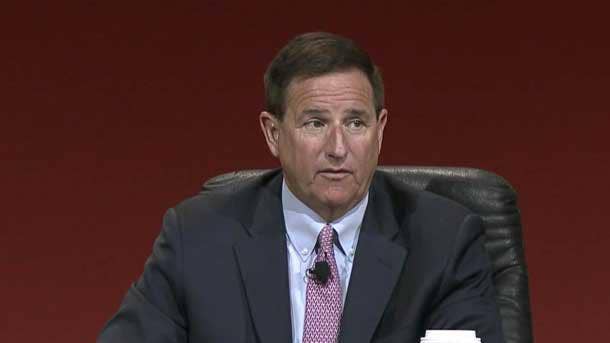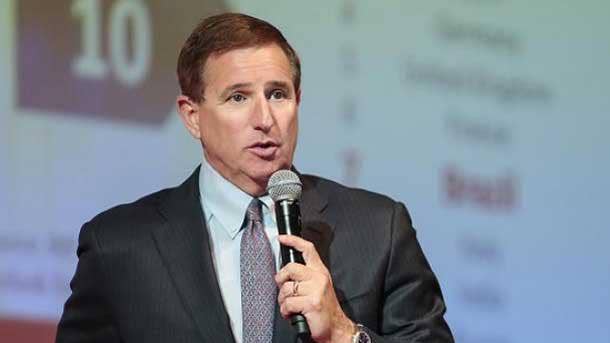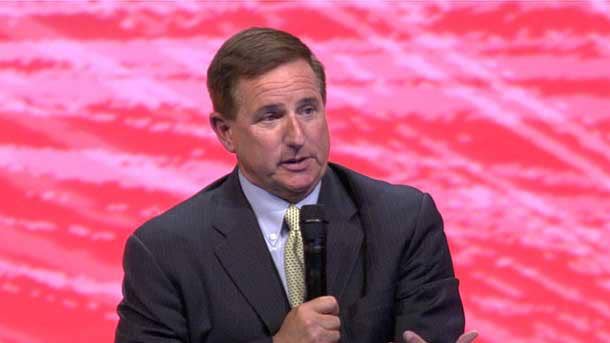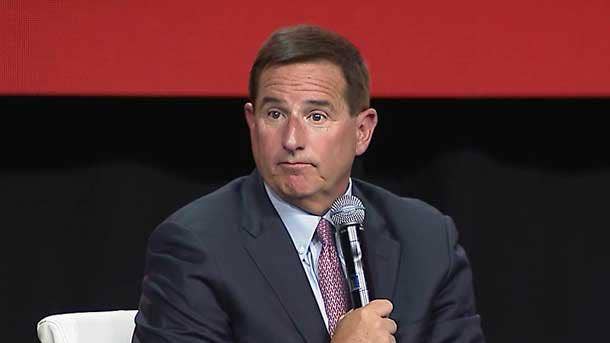Mark Hurd's 10 Most Provocative Statements At Oracle Media Day
Oracle CEO Mark Hurd spoke with reporters about his company's plans for leveraging its SaaS business to seize B2B market share in an imminent wave of massive business software consolidation.

Hurd Lays Out Oracle's Strategy For Market Supremacy
Oracle CEO Mark Hurd phoned in for a discussion with reporters from around the world who gathered Wednesday at the tech giant's Redwood Shores, Calif.-headquarters for Oracle Media Day.
The seasoned tech executive shared Oracle's plans for leveraging its leading SaaS business to seize B2B market share from competitors big and small. He also weighed in on the direction of the hybrid cloud market and how artificial intelligence will be delivered to business users under the hood of their application suites.
Overall growth in the U.S. and global economies doesn't necessarily translate directly to increases in B2B spending, Hurd said. At the same time, midmarket businesses are seeing an infusion of capital in the current environment, which has supercharged Oracle's already fast-growing NetSuite business.
As the IT market is upended by the cloud, and Software-as-a-Service absorbs traditional budgets for data center infrastructure, Oracle has its sights set on seizing market share in an imminent wave of massive business software consolidation, he said.
What follows is Hurd’s 10 most provocative statements at Oracle’s Media Day.

B2B Tech Spending Won’t Directly Follow Economic Growth
When you get to over 3 percent growth in GDP, generally tech should benefit from that. I do think most of what tech has benefited from has been in consumer tech as opposed to business-to-business tech.
Business-to-business tech is still very focused on trying to do a better job, taking care of technical debt that has built up over not just years but decades—trying to clean up its back-office systems so they talk to each other, and trying to clean up their front-office systems so they talk to the customer and do it seamlessly and deliver services.
So, I do think it’s a better economic environment. I don’t think we necessarily would take that GDP increase in growth and translate it necessarily into an exciting increase in B2B spending.

Current Economic Growth Uniquely Benefits NetSuite
I think the U.S. is doing very well. Particularly, U.S midmarket companies are getting benefit of an infusion of capital. They're investing.
Our NetSuite business has grown exponentially over the course of the past year, and that is mostly sold into small, medium business. Those growth rates have been outstanding. We've increased R&D, our number of sales reps, etc. but in the end its also been investment.

Changing SaaS Dynamics Will Help Oracle Seize B2B Market Share
We've got an applications market. Business-to business applications is roughly $125 billion. About 70 percent of that is back office, 30 percent of that is front office. Both are relatively fragmented. On-premises support revenue is the bulk of both categories. There's some emergent SaaS.
There is another dynamic here.
There isn't just the growth of applications, but as these application markets move to SaaS, we wind up with a problem, or an opportunity I should say, in the sense that the SaaS market absorbs hardware, absorbs database, absorbs middleware. So that market actually grows exponentially by just simply having the nature of it being a very inclusive market.
That market is going to grow big time just by the nature of what it does.

SaaS Will Drive An Imminent Wave Of Consolidation
The biggest player in the back-office market has only 24 percent share in on-premises. That market will actually consolidate as the market moves more and more to SaaS.
Most of the companies beneath the top two, none of them really have more than 3 percent market share. Most of them don’t have the R&D to invest in getting to true SaaS—true cloud, true features.
I think we're seeing it consolidate. I think, by the time we're done … there will be a long tail there … there will only be a couple big SaaS suite providers.
There's just incredible levels of interest in getting out of these old legacy systems and getting into these modern SaaS systems with all the new modern features that come with it.

SaaS Is A Major Revenue Multiplier
There's a phenomenon—if you take a dollar of support … generally speaking our customers convert that dollar of support to $3, $4 as it relates to moving to SaaS.
They move their data center to us, they move their servers to us, they move their storage to us, they move their database to us, they move their middleware to us.
We wind up doing more than we did, we wind up gaining share if you will with the customer. The customer winds up saving 30 percent from all the various categories. That's a rough guideline.
So, for the customer it's a very attractive value proposition. Obviously for us it's an attractive value proposition. But just moving our existing user base … from on-premises support to SaaS would roughly double our applications revenue.
Moving our user base is extremely attractive.

Oracle Has A List Of Small Competitors It’s Ready To Conquer
We've got a long list of sort of underfunded competitors who have 1 percent, 2 percent market share that don't have the investment to be able to move to more modern capabilities the customers are now hoping for and expecting.
So we have a material opportunity to gain share.

SAP's Cloud Migration Strategy Provides Oracle Another Conquest Target
SAP is telling customers they have to move—you have to move your application.
The context of this is you take the same existing workflow of the application and move it from your data center to another data center. By the end of the day, you still have the same workflow.
The problem when you move it, whatever changes or customizations you made to the application, you have to redo those all over again, and of course pay for it them over again.
To be able to have the same functionality when you go live on it, you have to not just make up one year's worth of them, but all of them you've done.
So some of these customers on these 'replatforms' can be facing bills of tens or hundreds of millions of dollars.
They have to go in front of their boards and get justification for tens and hundreds of millions of dollars. That's going to cause the board of directors to say things like, 'have you looked at any other alternatives, do you have any other bids. It can't be we're just going to write a check because you said so.'
And particularly when it doesn't really bring with it any automation, any of these new features, it's really the same on-prem workflow you've had before.
It's in many ways why this market is so attractive. Because the winner isn't going to be just us taking our user base and converting it there and doubling revenue. It's going to be gaining a lot of share.

Hybrid Cloud Isn't Going Anywhere, But Will Skew Public
The hybrid world will be around for a while, but there will be less of it on-premises and more of it in the cloud. Getting people to nimble architectures is key. Getting out of these static, fixed architectures, fixed cost structures, is where they need to go.
Everybody is going to move to modern applications when they can. Those are going to be SaaS. Those are going to be cloud, dev-test, which is a big part of IT, is going to move to cloud.
There are going to be certain workloads, and certain industries, in places like financial services, pharma, that will have regulatory issues that slow down things here or there.
By the time we get to the early part of the next decade, you're going to see 40, 50 percent of all these workloads in the cloud. Just last year, 15, 16 percent of the data centers in the U.S. closed.

AI Will Be Invisible
Some of these newer technologies really evolve into features that get integrated and embedded into core applications.
Instead of thinking of AI as, 'I'm gonna take a bunch of data, ship it to some mart, and then run a bunch of AI tools against it,' I think you're going to see AI brought to the data.
You'll hear about an HR recruiting application, an HR onboarding application, and that's going to be AI driven.
All of this can now be automated. This is going to show up in supply-chain applications, this is going to show up in finance applications, in HR applications. This is going to wind up as an embedded feature and you won't even know the AI is there.

NetSuite Demonstrates How AI Is Revolutionizing Database Performance
As we move into the autonomous database, that's all AI-driven at its core.
As an example, NetSuite is 15 years of coding from some of the smartest programmers in the world. They wrote I think around 9,000 indexes to the NetSuite application over the course of those 15 years to optimize the performance of the app. We put it on the autonomous database, and the database wrote 6,000 indexes … in less than 24 hours and got up to 6 or 7 percent better performance.
Fifteen years of the smartest programmers in the world writing one of the most successful applications in the world, and all of a sudden, in half a day, all that work was done by the computer.
That performance is not a one-time gain. It's iterative. As the indexing gets better and better by the machine, you get better and better performance.
Now, will we call that AI or will we call that the autonomous database. We call that the autonomous database.